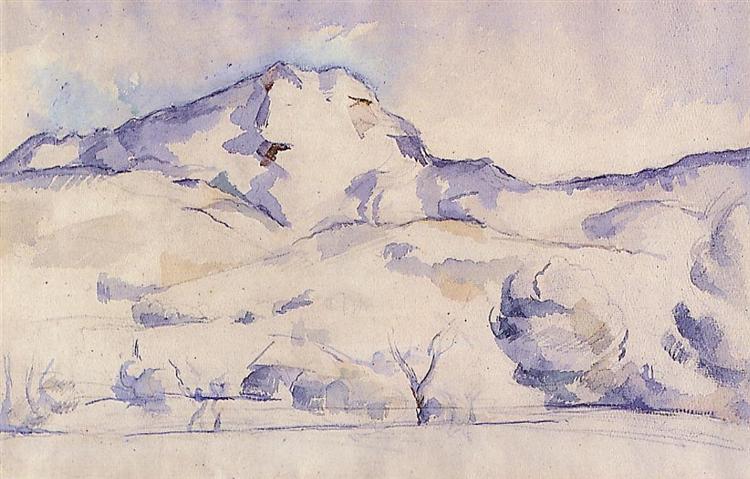Opis
Obraz „Mont Sainte-Victoire” Paula Cézanne'a, utworzony w 1887 r., Jest przedstawiony jako wzniosła manifestacja prowansalskiego krajobrazu, który zajmował centralne miejsce w pracy nauczyciela postimpresjonistycznego. Ten obraz, podobnie jak wiele innych z Cézanne, oddaje wyjątkową wizję słynnej góry, która wznosi się majestatycznie na horyzoncie Aix-en-Provence. W tej pracy Cézanne wykazuje kompozycję, która, choć najwyraźniej prosta, ujawnia formalną strukturę i chromatyczne bogactwo, które podnosi ją nad zwykłym krajobrazem.
Cézanne stosuje geometryczne podejście do budowania kształtu Mont Sainte-Victoire, wykorzystując szereg planów sugerujących objętość i głębokość. Szczyt koncentruje się na kompozycji, dominując w przestrzeni o jej solidnym kształcie, podczas gdy drzewa, które flanują podstawę góry i pola, które rozciągają się wokół, uzupełniają równowagę wzroku pracy. Ta interakcja między górą a środowiskiem ujawnia skrupulatną uwagę na krajobraz, w którym Cézanne rozpoczyna przejście od impresjonizmu do bardziej ustrukturyzowanego stylu, który przewiduje modernizm.
Paleta kolorów to kolejny niezwykły element tego obrazu. Cézanne stosuje kombinację żywych zieleni wraz z tonami niebieskiego i ochry, co nie tylko sugeruje jasność krajobrazu, ale także tworzy poczucie głębokości atmosferycznej. Pokrycia pędzla są widoczne i określone, co dodaje namacalnej tekstury na powierzchnię farby. Interesujące jest zauważenie, w jaki sposób Cézanne udaje się przekazywać szept światła w naturze poprzez zastosowanie kolorów, gdzie każdy ton nakłada się na następujące, generując efekt wizualny wizualny.
W tej pracy, w przeciwieństwie do innych reprezentacji krajobrazu, liczby ludzkie lub elementy narracyjne nie są włączone. Ten brak postaci pozwala widzowi w pełni zanurzyć się w doświadczeniu krajobrazu, promując bardziej intymny i prawie kontemplacyjny związek z środowiskiem naturalnym. Cézanne wydaje się opowiadać się za czystością krajobrazu samego w sobie, izolując górę jako niemal świętą istotę, powtarzającym się tematem w jego dziele, który odzwierciedla jego fascynację naturą i poszukiwanie niezbędnych.
„Mont Sainte-Victoire” można również zrozumieć jako część serii dzieł, w których Cézanne bada różne podejścia do tego samego tematu. Ten obraz jest jedną z kilku wersji, które artysta wykonał przez całe życie. Każdy z nich ujawnia nowe zrozumienie formy i światła, a chociaż jest on w szczególności w określonych ramach czasowych, wpływ jego stylu nadal rezonuje we współczesnej sztuce.
Podsumowując, „Mont Sainte-Victoire” z 1887 r. Jest świadectwem zdolności Cézanne do przekształcenia krajobrazu rodzinnego w potężne stwierdzenie estetyczne. Praca wzrasta jako kamień milowy w historii sztuki, co oznacza kluczowe przejście do bardziej abstrakcyjnych form ekspresji artystycznej. Poprzez jego skład, kolor i brak ludzkich postaci, ustanowiony jest pomost między prawdziwą a koncepturą, zachęcając widzów do kontemplowania istoty natury i jej artystycznej reprezentacji. Cézanne, ze swoją niepowtarzalną wizją, udało się uchwycić nie tylko miejsce, ale także stan emocjonalny, czyniąc tę pracę niezaprzeczalnym klejnotem postimpresjonizmu.
KUADROS ©, słynna farba na ścianie.
Ręcznie wykonane obrazy olejne, z jakością profesjonalnych artystów i charakterystyczną pieczęcią KUADROS ©.
Usługa reprodukcji zdjęć z gwarancją satysfakcji. Jeśli nie jesteś w pełni zadowolony z repliki twojego obrazu, zwrócimy twoje pieniądze w 100%.

